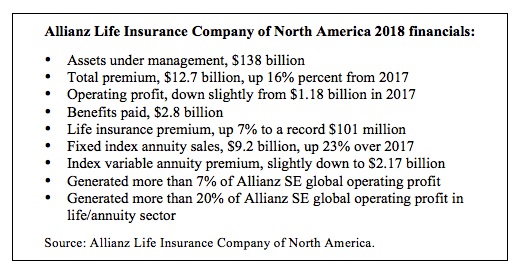
There was a shaky moment in 2007 when it looked as if Allianz SE’s bet on the U.S. insurance market might backfire on the German financial services giant. American regulators had placed the company’s Minneapolis-based subsidiary, Allianz Life of North America, in their crosshairs.
As part of a nationwide investigation into sales of complex “equity index annuities” (EIAs) to senior citizens, a state attorney general and a U.S. Senate Aging committee were scrutinizing Allianz Life’s notably successful but allegedly deceptive “two-tier” deferred index annuity contracts.
“The Allianz MasterDex 10 product [has] features that are never explained to the customer, and they wouldn’t understand it anyway,” said an official from the North American Securities Administrators Association told senators. “Half the time, the agents who sell it don’t understand it,”
But the company survived the crisis. The German parent replaced the U.S. management team, settled the lawsuits, and got back to business. Although Allianz Life was second in sales of EIAs (now called fixed index annuities or FIAs) in 2008, it has ranked first in 18 of the last 19 years—in a product category whose annual sales have more than doubled since then, to almost $70 billion last year.
In this second segment of RIJ’s four-part series on the FIA industry, we take a closer look at the industry’s perennial sales leader. We talked to the founder of the predecessor of Allianz Life in the U.S., to the actuary who worked on its first index annuity, to Allianz Life’s current head of product innovation, its marketing team, and industry experts who’ve watched the life insurer’s business evolve.

The LifeUSA backstory
Allianz Life’s success with FIAs grew from the business developed by Robert “Bob Mac” MacDonald, the irreverent insurance man (“Cheat to Win” was the title of his first book) who started a life insurance company called LifeUSA in the 1980s, took it public, and sold it to Allianz SE for $540 million in 1999.
LifeUSA’s 1990s product and distribution strategy survives remarkably intact at Allianz Life today. LifeUSA’s SEC filings from 1996 and 1997 reveal MacDonald’s recognition of the Boomer retirement opportunity and grasp of the impact of a topsy-turvy interest rate climate for issuers of fixed annuities.
Twenty-five years ago, rates gyrated. After falling from almost 10% in March 1989 to 2.66% in December 1993, the Fed funds rate shot up to 6% by March 1995. When official rates were low, fixed annuity issuers could (by buying longer-maturity bonds) offer investors higher yields than bank certificates of deposit (CDs). When the interest rates rose, however, fixed annuity owners wanted to break their contracts and chase yields.
“It was difficult for insurers to establish a credited interest rate on a fixed deferred annuity and retain the policy if interest rates changed,” MacDonald told RIJ in a recent interview. To make its FIA contracts stickier and more adaptive to fluctuating rates, LifeUSA indexed its crediting rates to the LIBOR (London Interbank Offered Rate).
“The actuaries and investment people were looking for a way to confront that volatility. The simple answer was, ‘Let’s index the interest rate. We’ll just credit one percent over LIBOR. If LIBOR goes down, we’ll still pay one percent more.’ Then we said, ‘If LIBOR goes up we’ll pay 50% of the increase. If it goes up by 3%, we’ll go up by 1.5%.’
“The whole idea was transparency. If these rates moved, you’ll be tied to that. That protected the company from disintermediation [premature surrender of contracts]. So we started out very simple. Other people started doing the same thing. Eventually you get to indexing the S&P500. So we said, ‘We’ll give the client 50% of the increase in the S&P up to 3%.”
LifeUSA wasn’t the first life insurer to bring an index annuity to market; that distinction goes to Keyport Life, with product design help from actuaries at Milliman, the global consulting firm. LifeUSA’s actuary, Brad Barks, had learned about indexing deferred fixed annuities to the S&P500 at a professional seminar and brought the idea back to MacDonald.
“The way the structure worked,” Barks, now an executive at RGA Reinsurance, told RIJ this week, “you’d start with $1,000 and promise to pay the policyholder x-amount at the end of five years. Ninety-percent of the premium accumulated at three percent [in the general account]. You then had 5% to 10% to spend on the option. Bob wanted to keep it simple. He always wanted to have levers to manage the profitability, and he didn’t want to offer guarantees that he didn’t know he could support.”
In 1996, LifeUSA introduced its first FIA contract, the Annu-A-Dex, which offered an initial 7% bonus on the premium and credited interest over a seven-year term. According to LifeUSA’s SEC filings, “The appeal of the product is that one can buy a competitive fixed annuity, with principal and interest guaranteed, and should the S&P 500 Index outperform the annuity over a seven-year period, one-half of the incremental growth is added to the value of the annuity.”
In its first year, Annu-a-Dex accounted for less than one percent of LifeUSA’s annual annuity premiums. Three years later, in 1999, “LifeUSA was doing $3 billion to $4 billion of annuity premium. That was a significant amount at the time. We were reinsuring half of that with Allianz Life, as coinsurance,” MacDonald told RIJ. At the time, LifeUSA was rated B++ (Very Good) by A.M. Best.
“Now Allianz SE is saying to themselves, ‘We’re making a lot money reinsuring this little company; why make only half of that money? We’re a trillion dollar company; why not get it all? MacDonald’s wild and crazy, but he’s created something.’ At the time they were criticized for paying a 100% premium for LifeUSA shares. But they will tell you today that it was dirt-cheap in the long run.”
Today’s top-selling FIA
Allianz Life’s best-selling fixed index annuity contract today is the Allianz 222, which was introduced in January 2013. The product offers a complex array of benefits and options, including eight index choices, three crediting methods, a 22% bonus on the PIV (protected income value), a crediting rate bonus, and guaranteed annual income starting at 5% (4.5% for joint contracts) of the PIV at age 65.
The contract epitomizes the FIA product category: It’s bewildering to ordinary people. It even resembles the two-tier products that got Allianz Life in trouble in 2007, except that, instead of having to annuitize to enjoy the bonuses, contract owners have to exercise the lifetime income rider. It has penalties and a market value adjustment on excess withdrawals during the first 10 years. Yet insurance agents have made it the hottest seller in the hottest annuity product category.
.jpg)
Matt Gray
We asked Matt Gray, the firm’s senior vice president for product innovation, to describe the product’s appeal to prospects. “The appeal comes from its income focus,” he told RIJ. “The income feature is built in; there’s no additional fee for it. There’s a ten-year wait on income, so it’s geared for 55-to-60-year-olds. Income starts at five percent of the PIV at age 65, goes up by 150% of the crediting interest each year, and can never go down.
“There are additional features that people love,” Gray said. “The Protected Income Value can be distributed as a death benefit over five years. There’s an Income Doubler feature for people who can’t perform at least two activities of daily living. Increasing income is perhaps the biggest feature. This contract is for someone who is looking for income and likes the flexibility of the other features.”
“Allianz Life has very innovative product development,” said Sheryl Moore, CEO of Wink, Inc., the life insurance and annuity market research firm in Des Moines, IA. “Their products have a ‘blue ocean’ aspect: they’ve developed stuff that people never heard of before.”
As the top-seller, Allianz 222 naturally has a target on its back. Bryan Anderson, a Northwest Montana insurance agent and direct seller of FIAs through his website, AnnuityStraightTalk.com, believes that the contract is over-sold and, in some cases, mis-sold to older people who may not realize that they have to wait 10 years to enjoy the product’s full value.
“There’s nothing wrong with the product itself,” Anderson told RIJ. “But it’s often sold in situations where another product—maybe a narrower product or a product where the client can’t afford to wait ten years for income to begin—would be more appropriate.”
Anderson has published a critique of the Allianz 222. He believes that it’s a favorite of agents who have no expertise in creating personalized income strategies for retirees.
“A lot of advisors don’t understand the decumulation game,” he said. “If you have an advisor who has been selling only life insurance and mutual funds for 30 years and you show him a glossy Allianz Life product brochure, and if he sees only that, he will sell it. I see advisors do that all the time.”
To read the second part of this article, click here.

